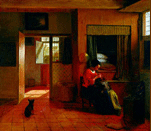










24.
Between Punishment and Discipline:
Early Modern Workhouses and the Public Woman
Organizers:
Methodology:
Material:
Description of Primary Materials
Bridewell 1553-1557
Bridewell Royal Hospital was established in 1553 by a grant from King Edward
VI to the mayor, commonalty and citizens of London, as part of a larger initiative
for dealing with urban poverty and vagrancy. Documents related to the Hospital’s
founding, the indenture of covenants by which Edward VI established the hospital
(1553) and the ordinance and rules for its governance (1557), offer an idealized
vision of the institution’s aims and practices, a vision predicated
on discernment between ordered and disorderly public spaces and on gendered
notions of acceptable behavior for London citizens. These documents present
Bridewell as an institution that could maintain order in the rapidly changing
London metropolis.
Spinhuis 1596-1645
Amsterdam’s workhouse for women, its Spinhuis, was founded in 1596,
situated in buildings that originally had belonged to the convent of St. Ursula
and were dedicated to the rehabilitation of idle or wandering girls, maids,
and women through employment in sewing, knitting, and spinning. In 1643 the
hybridized structure of the former convent burned. In 1645 a new Spinhuis
was erected. This structure, its organization and use, as well as its inmates
belong to a new kind of urban institution that is conceived on the basis of
blurring the traditional distinctions between public and the private in the
early modern period. With the Spinhuis in particular, there are numerous problematic
areas, including its relation to changing behavior standards for women, to
presumptions about women’s labor, and to the relationship between independence
and prostitution. The rich symbolic economy of spinning, and the Netherlandish
preoccupation with women engaged in interior settings quietly absorbed in
needlework, also add nuanced layers of understanding to the Spinhuis’
occupants and their activities. Their spatial segregation, their cloistered
institutional affiliation, contrast with the clear exterior markings of the
building in which its clientele are depicted in varying degrees of diligence
and disobedience.
Bridewell 1660-1681
Despite the fact that the original Bridewell Hospital burned in 1666, a significant
number of the Court Books from the late Stuart period are extant. Those records
present a complex archive for scholars of early modern sexuality. Not only
do the minutes from the Court of Governors chronicle the commitments and discharges
of inmates for the court’s biweekly meetings, but they are combined
with the court’s other mission to put poor orphan boys to work. Consequently,
each set of minutes lists a series of petitions and declarations that pertain
to the establishment of trades within the Hospital’s precincts, the
rent charges for tradesmen and their families, and various other sorts of
business. The workshop will offer participants one full set of minutes from
the biweekly meetings in order to illustrate the archive’s deep structure.
The example will also illustrate the ways in which the archive prompts scholars
to think about the rich and intricate ways multiple analytical categories
intersect to delineate sexuality and public space during the late Stuart period.
Workshop participants will be supplied with the following packet of material prior to the conference as well as a list of additional suggested readings.
Founding documents for Bridewell Hospital. 3 pp.
4 images of Spinhuis and 1 seventeenth-century poem that describes the workhouse.
3 Minutes from Bridewell Court of Governors 17 March 1681 (transcribed).
Laura Gowing, “’The Freedom of the Streets’: Women and Social Space, 1560-1640,” in Londinopolis: Essays in Cultural and Social History of Early Modern London eds, Mark Jenner and Paul Griffiths (Manchester: University of Manchester Press, 2000), 130-151. 11 pp.
|
|
|
||||||
|
|
 |
 |
|
||||
 |
|
 |
|
||||
|
|
|
||||||
|
|
|
||||||
 |
|
||||||
|
|
|
||||||
| |
|
||||||
 |
|
||||||
 |
|
||||||
 |
|
||||||
 |
|
||||||
|
|
|
||||||
|
|
 |
|
|
||||
 |
|
||||||
|
|
|
|
|
|
|
|
|